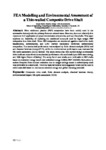FEA modelling and environmental assessment of a thin-walled composite drive shaft

Date
2022-11Author
Subject
Metadata
Show full item recordAbstract
Fibre reinforced plastics (FRP) composites have been widely used in the automotive industry with the primary focus on reduced mass. However, there are relatively few reports on their application on power transmission components, such as drive shafts. This paper explores the feasibility of replacing the traditional structural steel by light weight FRP composites in a drive shaft. Three FRP composites are considered against a steel drive shaft; basalt/epoxy, carbon/epoxy, and CNT (carbon nanotubes) reinforced carbon/epoxy composites. The mechanical performance was analysed by finite element analysis (FEA) tool and classical laminate theory (CLT), while the environmental performance was evaluated by life cycle assessment (LCA) method. The study shows that with careful design a composite drive shaft can outperform the mechanical performance of a steel shaft (up to 90% mass saving, and 50% higher Factor of Safety). The study found steel shafts were preferable to FRP shafts based on embodied energy (steel total embodied energy 150MJ, FRP +325MJ). Reductions in carbon footprint from reduced emissions due to weight savings meant a carbon/epoxy shaft was preferable to a steel shaft. Two new material indices were suggested which can be used to select materials based on minimum embodied energy and global warming potential.
Description
Collections
Publisher
Journal
Volume
Pagination
Number
Recommended, similar items
The following license files are associated with this item:

